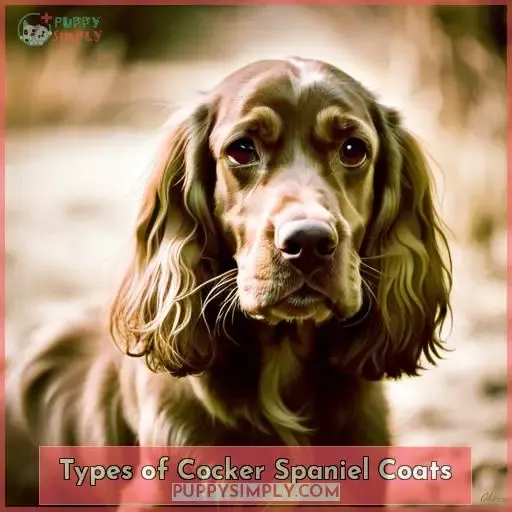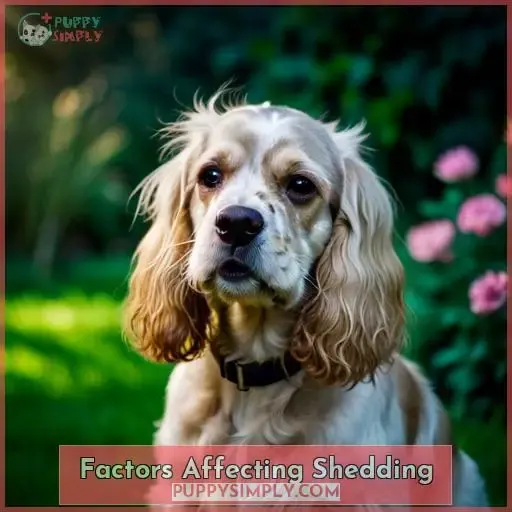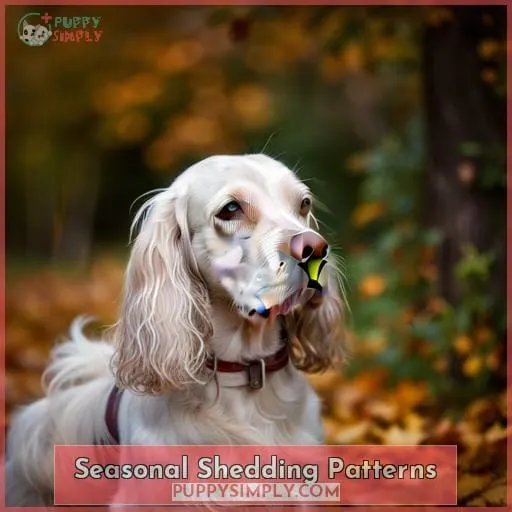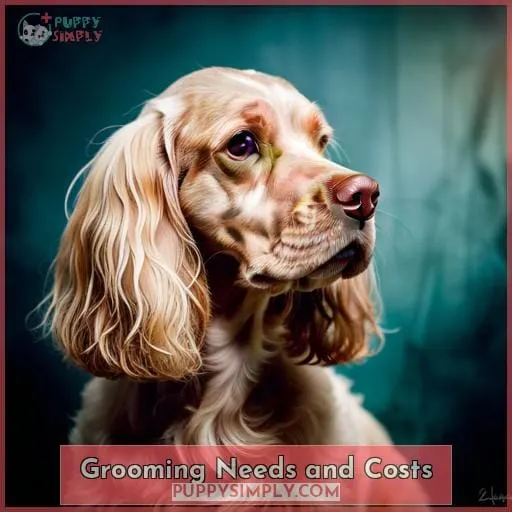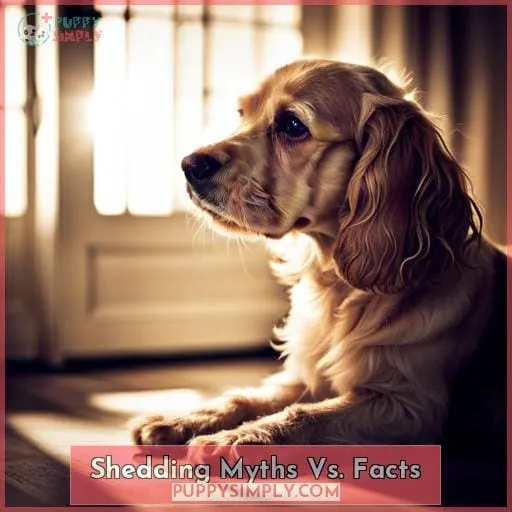This site is supported by our readers. We may earn a commission, at no cost to you, if you purchase through links.
 You’re considering bringing a Cocker Spaniel into your home, but you’re worried about the shedding.
You’re considering bringing a Cocker Spaniel into your home, but you’re worried about the shedding.
You want a dog that’s easy to care for and won’t leave your house covered in fur.
In this guide, we’ll answer the question: Do Cocker Spaniels shed?
We’ll also provide tips on managing their coats.
We’ll discuss the different types of Cocker Spaniel coats, factors that affect shedding, and the grooming needs of this breed.
Table Of Contents
- Key Takeaways
- Cocker Spaniels Do Shed
- Types of Cocker Spaniel Coats
- Factors Affecting Shedding
- Seasonal Shedding Patterns
- Managing Cocker Spaniel Shedding
- Are Cocker Spaniels Hypoallergenic?
- Grooming Needs and Costs
- Shedding Myths Vs. Facts
- Frequently Asked Questions (FAQs)
- How much exercise does a Cocker Spaniel need to minimize shedding?
- What are some recommended fish oil or vitamin supplements to reduce shedding?
- What cleaning products work best for removing Cocker Spaniel fur from furniture and clothes?
- Can a change in diet help reduce shedding amount and frequency?
- Are there any effective home remedies to help with excessive Cocker Spaniel shedding during seasonal transitions?
- Conclusion
Key Takeaways
- Cocker spaniels shed moderately year-round, with increased shedding during the spring and fall coat transition seasons.
- Factors like health, environment, stress levels, and nutrition impact the amount of shedding.
- Regular grooming, bathing, and brushing can help manage shedding.
- Cocker spaniels have undercoats and varying coat textures that require diligent care to prevent mats and tangles.
Cocker Spaniels Do Shed
You’re in for some shedding if you’ve got a Cocker Spaniel.
Their gorgeous, silky coats require regular grooming to keep shedding under control.
Invest in quality brushes and combs for frequent use.
Daily brushing removes dead hairs before they fall onto your furniture.
Bathe monthly with moisturizing shampoo to hydrate skin and fur.
Schedule professional grooms as needed for clipping and handstripping.
Shedding solutions include omega supplements, vacuuming frequently, and washing bedding weekly.
Manage allergies through grooming, air filters, medication, and limiting exposure.
Prepare for heavier seasonal shedding in spring and fall by increasing grooming frequency.
With diligent coat care, you can manage Cocker Spaniel shedding and enjoy their wonderful companionship.
Types of Cocker Spaniel Coats
As we’ve explored, Cocker Spaniels certainly shed their soft, silky coats.
This breed sports a dense undercoat capped with longer guard hairs exhibiting varying degrees of feathering. Their coats range from smooth to quite wavy, presenting unique grooming challenges.
A Cocker’s shedding triggers include seasonal shifts, health changes, and environmental stresses.
Maintaining coat health requires diligent brushing to limit mats and tangles that exacerbate shedding.
Adapt grooming to match your Cocker’s coat texture, feathering variations, and sensitivity to shedding triggers.
This individualized approach keeps their beautiful coats healthy while limiting shedding.
Factors Affecting Shedding
As you likely know, shedding in Cocker Spaniels can be influenced by various factors.
A dog’s health and environment play key roles in coat quality and shedding tendencies.
We’ll explore how aspects like nutrition, seasonal changes, and stress levels may increase shedding in the breed.
Health
Depending on your dog’s health, you’ll deal with more or less shedding.
Genetic influences, dietary impact, environmental factors, allergies management, and grooming techniques all play a role.
Regular grooming, an appropriate diet, proper hygiene, and addressing seasonal shedding can help minimize loose hairs around your home.
Environment
Your home’s temperature and humidity impact your Cocker Spaniel’s shedding.
Indoor factors like heating affect their coats, while outdoor influences like seasonal changes prompt heavier shedding as they adapt.
This can exacerbate allergies, so adjust grooming accordingly, using moisturizing shampoos and thoroughly combing their fur to remove dead hairs.
With proper at-home grooming routines tailored to environmental factors, you can better manage messy shedding and maximize your dog’s coat health.
Seasonal Shedding Patterns
You’re likely to notice your Cocker Spaniel shedding more during the seasonal coat transitions in spring and fall when they blow their undercoats.
Spring shedding
Fall shedding
Year-round shedding
As seasons change, Cocker Spaniels shed old coat layers to make way for new fur growth suited to the updated weather conditions. Shedding frequency and volume peaks during the spring and fall seasonal coat transitions as Cocker Spaniels blow their undercoats, though shedding continues year-round.
Regular combing and proper grooming techniques can help manage messy shedding during peak transitions.
Understanding natural shedding patterns and properly managing a Cocker Spaniel’s coat supports healthy skin, minimizes allergy triggers, and maintains the breed’s beautiful silky fur.
Managing Cocker Spaniel Shedding
You’ll want to regularly brush your Cocker Spaniel’s coat to remove loose hairs and prevent mats from forming.
Additionally, regular bathing can help reduce shedding by loosening dead hairs in their coat.
Sticking to a brushing and bathing routine is key to managing your Cocker Spaniel’s shedding.
Regular Brushing
Brush your dog frequently to control shedding and prevent knots in their long, wavy coats.
Using proper brushing techniques loosens dead fur so it doesn’t get trapped.
If you lack confidence grooming at home, take your cocker spaniel to a professional groomer regularly.
This maintains their coat, manages allergies, and debunks shedding myths.
Understanding cocker spaniel coats and proper brushing prevents matting and excess shedding while keeping your pup comfortable.
Bathing
Additionally, bathe your Cocker Spaniel regularly with a moisturizing shampoo to help loosen and remove excess fur that’s ready to shed from their coat.
As a groomer, I recommend brushing before baths to gently lift dead hairs from the undercoat.
Select quality shampoos that hydrate skin and hair follicles while stimulating the coat’s natural oils.
Bathing every 2-4 weeks prevents product buildup that can trigger excess shedding.
Always use specifically designed grooming tools for the safest, most effective approach when maintaining your cocker spaniel’s coat.
Are Cocker Spaniels Hypoallergenic?
Unfortunately, Cocker Spaniels aren’t hypoallergenic despite myths claiming otherwise.
Their gorgeous, flowing fur traps dander and proteins that trigger allergies.
While no dog is 100% hypoallergenic, some shed less, producing fewer allergens.
Cocker Spaniels have moderate shedding from their double coats.
Their long, silky hairs also stick to clothing and furniture, spreading allergens.
Don’t be fooled by shedding myths.
Grooming tips like regular brushing, bathing, and vacuuming can help reduce shedding and manage allergies.
But Cocker Spaniels’ coat characteristics mean allergens persist.
Focus allergy management on medication, air filters, washing bedding weekly, and bathing your pup often with hypoallergenic shampoo.
Grooming Needs and Costs
As a groomer, I recommend considering both at-home grooming and professional grooming for your Cocker Spaniel.
Their long, silky coats require thorough combing every few days to prevent mats and tangles.
Professional grooming can be costly but may be worthwhile if you don’t feel up to the task of maintaining their high-maintenance coats yourself.
At-Home Grooming
For managing shedding at home:
- Brush your Cocker Spaniel regularly with a slicker brush and metal comb to remove loose hairs and prevent mats.
- Use long strokes in the direction of hair growth, checking for tangles.
- Trim overgrown fur between paw pads with rounded-tip scissors to prevent painful mats.
Schedule professional grooming if DIY proves difficult, especially for nails and sanitary trims.
Professional Grooming
The cost of grooming provides quality results if you’re overwhelmed by home coat care.
- Groomers have extensive training in grooming techniques and proper tools to maintain healthy coats. They can efficiently comb through the coat, preventing mats and knots.
- Visiting a groomer every 6-8 weeks ensures your Cocker Spaniel’s coat is clean, cool, and comfortable during warmer weather when shedding increases.
- Professionals also provide expert advice on at-home care between appointments so you can properly maintain the coat.
- While professional grooming has added costs, the results are superior to do-it-yourself grooming, saving you time and frustration.
Shedding Myths Vs. Facts
When combating misconceptions about shedding, you’ll find Cocker Spaniels don’t completely stop shedding in certain seasons and aren’t truly hypoallergenic breeds.
Shedding Realities:
- Shed year-round, not just seasonally
- Amount varies by individual
- Health and environment influence shedding
- Transitions between coat types cause spikes
- Can’t eliminate shedding entirely
Allergy Considerations:
- Can still trigger allergies
- Less shedding may reduce symptoms
- Reactions depend on individual
- No breed is non-allergenic
Grooming Insights:
- Regular grooming helps manage shedding
- Brushing removes loose hairs
- Bathing benefits skin and coat health
- Professional grooming may be needed
- At-home grooming takes dedication
As a veterinarian and animal care professional, I aim to provide realistic perspectives on managing your pup’s coat. Shedding varies, but diligent grooming keeps it under control. Allergies remain a personal matter – interact with dogs first to gauge reactions.
Cocker coats demand commitment, but our insights equip you to enjoy their companionship.
Frequently Asked Questions (FAQs)
How much exercise does a Cocker Spaniel need to minimize shedding?
Exercise is important, but it doesn’t directly impact shedding in Cocker Spaniels.
Focus instead on:
- Regular grooming
- Healthy nutrition
- Minimizing stress
- Other proactive care measures
These steps can help manage shedding.
What are some recommended fish oil or vitamin supplements to reduce shedding?
Try giving your cocker spaniel omega-3 rich salmon oil or vitamin E supplements.
Check with your vet for the appropriate dosage for your dog’s size and age.
These can help nourish skin and coat health.
Brush frequently with a slicker brush and wide-tooth metal comb to remove loose hairs.
What cleaning products work best for removing Cocker Spaniel fur from furniture and clothes?
A lint roller removes surface fur from clothes.
For furniture, try a rubber pet hair brush or damp microfiber cloth.
Vacuuming with a pet hair attachment also helps lift fur from fabric.
Can a change in diet help reduce shedding amount and frequency?
Yes, adjusting your Cocker Spaniel’s diet can help reduce shedding.
Feed them high-quality food with omega-3 fatty acids, antioxidants, and vitamins that nourish skin and coat health.
Regular brushing also remains essential for removing loose hairs.
Are there any effective home remedies to help with excessive Cocker Spaniel shedding during seasonal transitions?
While home remedies may provide some relief, I can’t ethically recommend anything to treat excessive shedding without fully assessing your dog’s health.
Please schedule a veterinary exam so we can develop an appropriate, individualized plan to address the underlying cause and keep your Cocker comfortable.
Conclusion
As a seasoned groomer, I can attest that Cockers shed moderately year-round.
Regular brushing helps manage loose hairs so they don’t end up on your furniture.
Bathing them one to two times monthly can give their coats a clean restart to minimize shedding as well.
While no dog is truly hypoallergenic, Cockers tend to bother allergies less than heavy shedders.
With some elbow grease keeping up with their grooming, Cockers make bubbly companions without leaving too much fur behind.
Implementing a thorough brushing and bathing regimen is key to minimizing the shedding these playful pups do.


